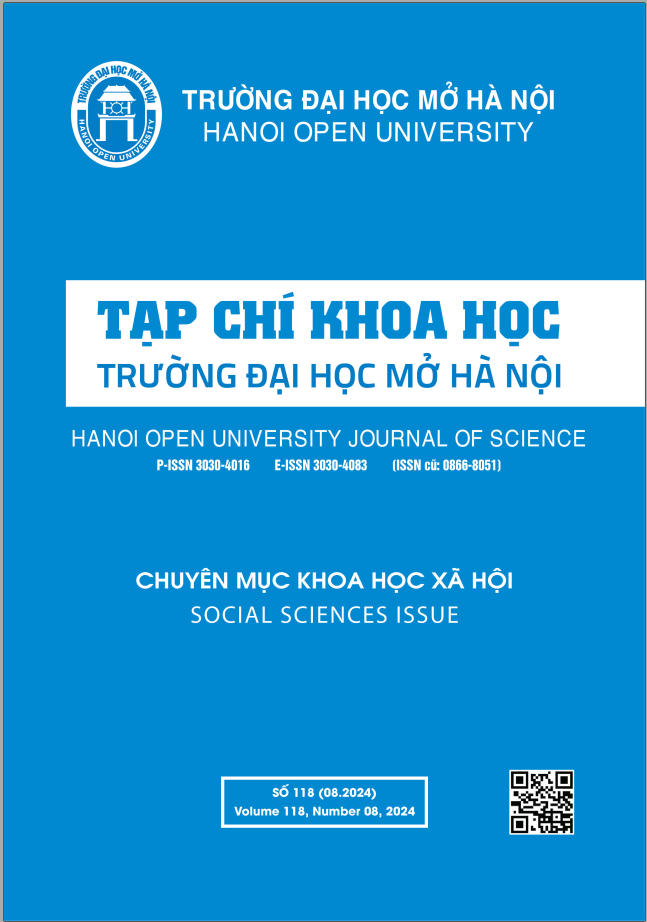IMPACT OF CAPITAL STRUCTURE ON PROFITABILITY OF VIETNAMESE INSURANCE COMPANIES
DOI:
https://doi.org/10.59266/houjs.2024.440Keywords:
Capital structure, Insurance company, profitabilityAbstract
Insurance companies have an important function of absorbing and storing economic risks. Therefore, companies need to have optimal, safe, and stable capital sources to be able to finance, diversify, and transfer risks. Previous studies have only focused on market share, customers, competitive strategies, and insurance premiums without paying attention to the capital sources of insurance companies. This is more necessary when Vietnamese insurance companies have a non-optimal capital structure, leading to low profitability. The study aims to fill the above gap by analyzing the impact of capital structure on the profitability of insurance companies through the research sample of the Data Set of 40 insurance companies (listed on HNX, HOSE, UPCOM), corresponding to 297 observations in the period from 2013 - 2023. By using GMM estimation, the author has identified three independent variables explaining (and two control variables) the variation of the dependent variable profitability (ROE), including (i) General debt ratio (GDR), (ii) Debt ratio (DR), (iii) Long-term debt ratio (LDR). Based on the research results, the authors discuss and assess the important role of capital structure in insurance companies and provide financial solution recommendations to improve their profitability.
References
[1]. Zou H, Adams MB. Debt capacity, cost of debt, and corporate insurance. Journal of financial and quantitative analysis. 2008;43(2):433-66.
[2]. Yaisawarng S, Asavadachanukorn P, Yaisawarng S. Efficiency and productivity in the Thai non- life insurance industry. Journal of productivity analysis. 2014;41:291-306.
[3]. StataCorp L. Stata spatial autoregressive models reference manual. Stata presses College Station; 2017.
[4]. Shawar K, Siddiqui DA. Factors affecting the financial performance of the insurance industry in Pakistan. Shawar, K and Siddiqui, DA (2019) Factors Affecting Financial Performance of Insurance Industry in Pakistan Research Journal of Finance and Accounting. 2019;10(5):29-41.
[5]. Sambasivam Y, Ayele AG. A study on the performance of insurance companies in Ethiopia. International Journal of Marketing, Financial Services & Management Research. 2013;2(7):138-50.
[6]. Reyna AM, Fuentes HJ. A cost- efficiency analysis of the insurance industry in Mexico. Journal of Productivity Analysis. 2018;49(1):49-64.
[7]. Nkwor NN, Ikpor IM. Firm Size and Growth: Testing Gibrat’s Law in the Nigerian Life Insurance Industry. Pertanika Journal of Social Sciences & Humanities. 2019;27(2).
[8]. Myers SC, Majluf NS. Corporate financing and investment decisions when firms have information that investors do not have. Journal of financial economics. 1984;13(2):187-221.
[9]. Myers SC. Capital structure puzzle. National Bureau of Economic Research Cambridge, Mass., USA; 1984.
[10]. Modigliani F, Miller MH. The cost of capital, corporation finance, and the theory of investment. The American Economic Review. 1958;48(3):261-97.
[11]. Kraus A, Litzenberger RH. A state- preference model of optimal financial leverage. The journal of finance. 1973;28(4):911-22.
[12]. Kigen WK. The effect of firm size on profitability of insurance companies in Kenya: University of Nairobi; 2014.
[13]. Ishtiaq N, Siddiqui DA. Factors affecting the financial performance of the life insurance sector in Pakistan. Ishtiaq, Nazish and Siddiqui, Danish Ahmed,(2019) Factors Affecting Life Insurance Sector Financial Performance in Pakistan International Journal of Social and Administrative Sciences. 2019;4(2):178-99.
[14]. Hock Ng T, Lee Chong L, Ismail H. Firm size and risk-taking in Malaysia’s insurance industry. The Journal of Risk Finance. 2013;14(4):378-91.
[15]. Harris M, Raviv A. The theory of capital structure. The Journal of Finance. 1991;46(1):297-355.
[16]. Hansen LP. Large sample properties of generalized method of moment estimators. Econometrica: Journal of the econometric society. 1982:1029-54.
[17]. Donaldson G. Corporate debt capacity: A study of corporate debt policy and the determination of corporate debt capacity: Beard Books; 1961.
[18]. Burca AM, Batrinca G. The determinants of financial performance in the Romanian insurance market. International journal of academic research in accounting, finance, and management sciences. 2014;4(1):299-308.
[19]. Biener C, Eling M. Organization and efficiency in the international insurance industry: A cross-frontier analysis. European Journal of Operational Research. 2012;221(2):454-68.
[20]. Ben Dhiab L. Determinants of insurance firms’ profitability: An empirical study of the Saudi insurance market. The Journal of Asian Finance, Economics and Business. 2021;8(6):235-43.
[21]. Bawa SK, Chattha S. Financial performance of life insurers in the Indian insurance industry. Pacific Business Review International. 2013;6(5):44-52.
[22]. Aryonidito S, Yadiati W, Handoyo S. Effect of Market Share and Firm Size on Efficiency and its Implications for Profitability of Sharia Insurance in Indonesia. Journal of Accounting Auditing and Business-Vol. 2020;3(1).
[23]. Ahmed I. Effect of capital size on the profitability of listed insurance firms in Nigeria. African Journal of Business Management. 2016;10(5):109-13.
[24]. Ahmad AA, Habibah SN. Market Structure and Determinants of Firm Profitability on General Insurance Industry in Indonesia. Studies in Business and Economics. 2021;16(1):26-41.
[25]. Adams M, Andersson LF, Hardwick P, Lindmark M. Firm size and growth in Sweden’s life insurance market between 1855 and 1947: A test of Gibrat’s law. Business History. 2014;56(6):956-74.
